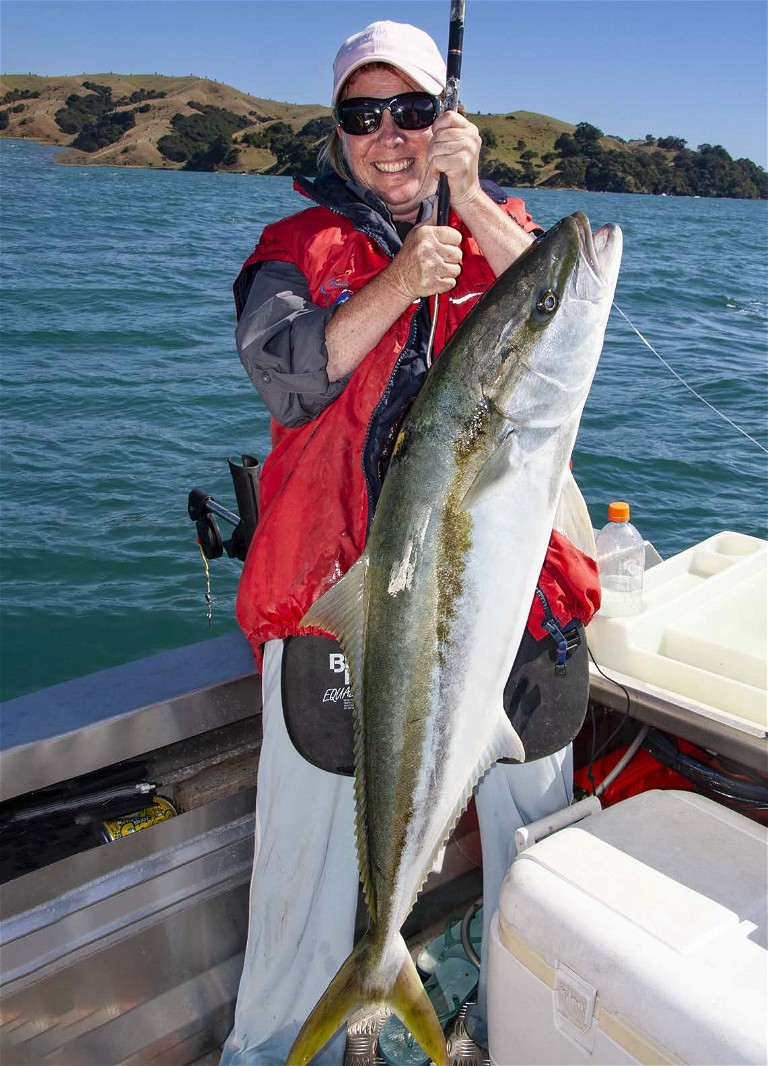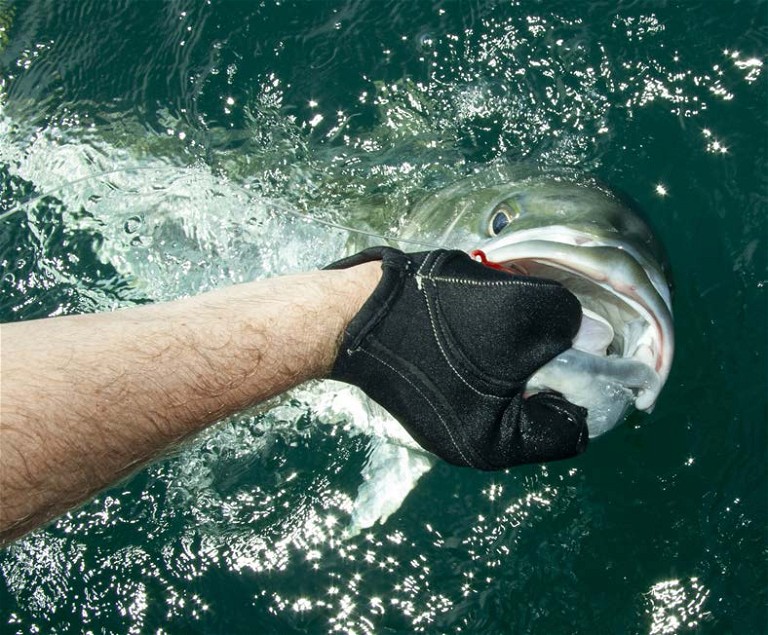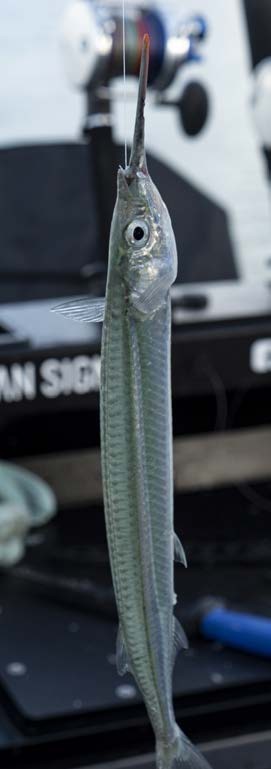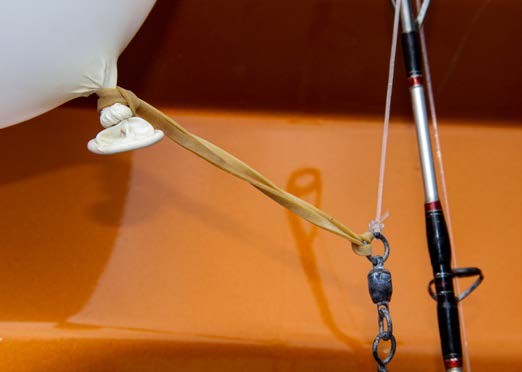LIVEBAITING BASICS
CATCHING, RIGGING, AND CARING FOR YOUR BAITS
Of all the forms of fishing, livebaiting would have to be one of the most productive for targeting big fish, says Adam Clancey.

A good gaff is needed to handle bigger fish.
All the popular target species in NZ (snapper, kingfish, marlin, and tuna, as well as bluenose, gemfish, hapuku, and bass) take livebaits willingly. However, livebaiting is far more than just hanging a live fish over the side and hoping that something will eat it. Whether you’re fishing from the shore or a boat, setting up for livebaiting properly and understanding the subtleties of different techniques will go a long way to producing excellent results.
Species selection
The first consideration: what is the best livebait for each species you want to target? There is a list of common livebaits that will work well on most species – piper, mackerel, kahawai, mullet, trevally, and small tuna, but there are also less commonly used livebaits that shouldn’t be overlooked, such as squid and flying fish. When the need necessitates it, a maomao or spotty will also turn on results. To be a good livebaiter, you first have to master the art of catching these species, and this can require anything from a set of baitfish flies, or a simple chrome spinner, right through to a cast net.
Tank considerations
Once you have secured your livebait, keeping it alive and in excellent condition is the biggest challenge. If land-based, a rock pool is great (if there’s one handy). Otherwise, a large bucket will suffice. You will have to add more water regularly to keep the water oxygenated and at the right temperature.
If you are dealing with big livebaits, a cheap blow-up paddling pool is a lightweight, versatile option. A small battery-powered aerator pump will also help keep your baits in prime condition. Most modern craft feature a livebait tank, or you can retrofit one to your boat. NZ company Hi-Tech Plastics produces a good range, including permanent and removeable options.
Larger livebaits like big kahawai or skipjack tuna need high volumes of water; this is where tuna tubes come into their own. A tuna tube uses a high-volume pump to force a constant stream of water over the gills of the baitfish so they do not need to swim around. It is essential to treat baits gently and not overcrowd your tank. The size of the baitfish will govern this.
Drift vs anchor
While most livebaiting is done on the drift or while trolling, especially for offshore species, there are times when anchoring is the best approach. If you don’t have an electric motor on a boat capable of holding you over the spot, you will need to set up a quick release on your anchor, so when you hook a big fish, you can release the anchor and chase your quarry. Staying on top of a big fish and reducing line angle will lessen the risk of you being taken to ground. The easiest anchor quick-release system is to have a separate anchor attached to a buoy, which is then dropped overboard when you need to move quickly.
Tackle options
You can use any rod and reel for livebaiting, although certain tackle will make things easier. Using slightly longer rods will help control the livebait and make it easier to set the hook and play the fish. Unlike lure fishing, where the strike and hook-up are instantaneous, when livebaiting, you often need to let the fish take the bait and run before you slowly add pressure (especially when fishing with circle hooks).

1) Kahawai make for are a reliable livebait.
1

2) Bridle rigging is an excellent way to slow-troll some baits. It also prevents them from being knocked off the hook from a hard strike.
2

3) You can land kingfish with a lip grip.
3
A rod of 1.8-2.2 metres, with a medium-action, slightly soft tip and very stiff butt section is ideal. Reels need to be sturdy, have good drags, and be able to fish in free spool. The obvious choices are lever drag overhead reels or bait feeders. Fishing in free spool, you can add enough pressure on the lever or bait feeder to keep the livebait from pulling off line until a predator strikes. Having minimal resistance on the take will make the fish less likely to spook, giving it time to gulp it down.
The rating of the rod, reel, and line is very much down to personal taste and usually based on the environment you are fishing. As a guide, I would suggest: for inshore kingfish – a 10-15kg outfit; for offshore and blue water – 15-37kg; and for land-based – 15-24kg. When it comes to line choice, braid is the most versatile. A significant advantage is that you can fish heavy breaking strain lines on smaller, lighter rods and reels. Combine this with the lack of stretch and excellent abrasion resistance when fishing over foul, and it’s a clear first choice.
The business end
Terminal tackle choices are super important when it comes to rigging livebaits. Carry a range of floats, balloons, and strong swivels, as well as a range of trace weights (24kg, 37kg, 60kg, and up to 100kg-plus if you are chasing billfish).
The main aim is to present your livebait in the most natural way possible with a sensible leader. A great example of this is when fishing with live piper. If you use a heavier leader and hook, your bait will sink to the bottom, where it will likely snag and die. In most cases, we rig piper with 37kg trace and small strong circle hooks, which are placed carefully through the bill. This keeps them swimming for hours. Alternatively, if rigging a two-kilo kahawai for a big kingfish or marlin, the trace would be 100kg, and the bait would be bridle rigged with a 12/0 circle hook. In all cases, use a leader length of 2-4 metres. Wind-on leaders should be attached using an FG knot, hollow braid splice or a bobbing knot.
Having all the right gear will help you get on the fish. It’s things like having a little dip net to catch your baits in the livebait tank; setting up your tackle box with the right terminal tackle (like the correct size of rubber bands and needles for doing speedy bridal rigs); and having the gimbal adjusted to suit the angler before you need it. If you get all of these little aspects right, your chances of success will massively improve.

4) Piper should be deployed with a light trace and hook to prevent them from being dragged to the bottom.
4

5) Adam uses a rubber band to attach his balloon to the swivel when deploying livebaits.
5

6) Tuna tubes, whether built into the transom or fixed after-market, are great for keeping bigger baits such as kahawai and skipjack tuna alive.
6